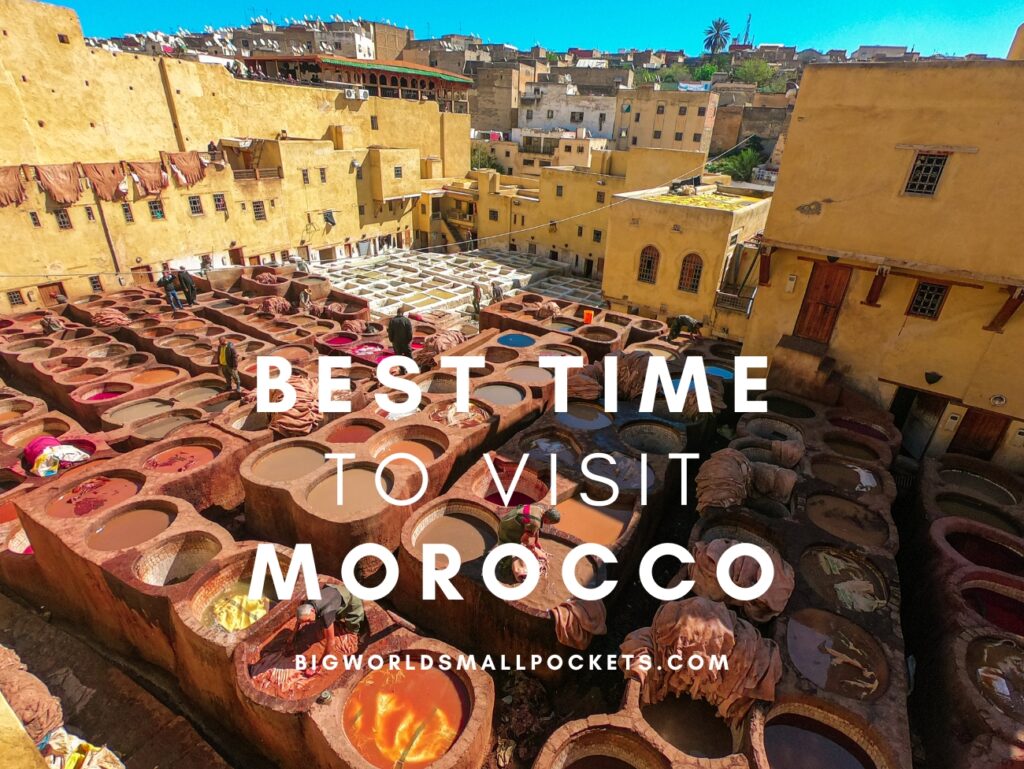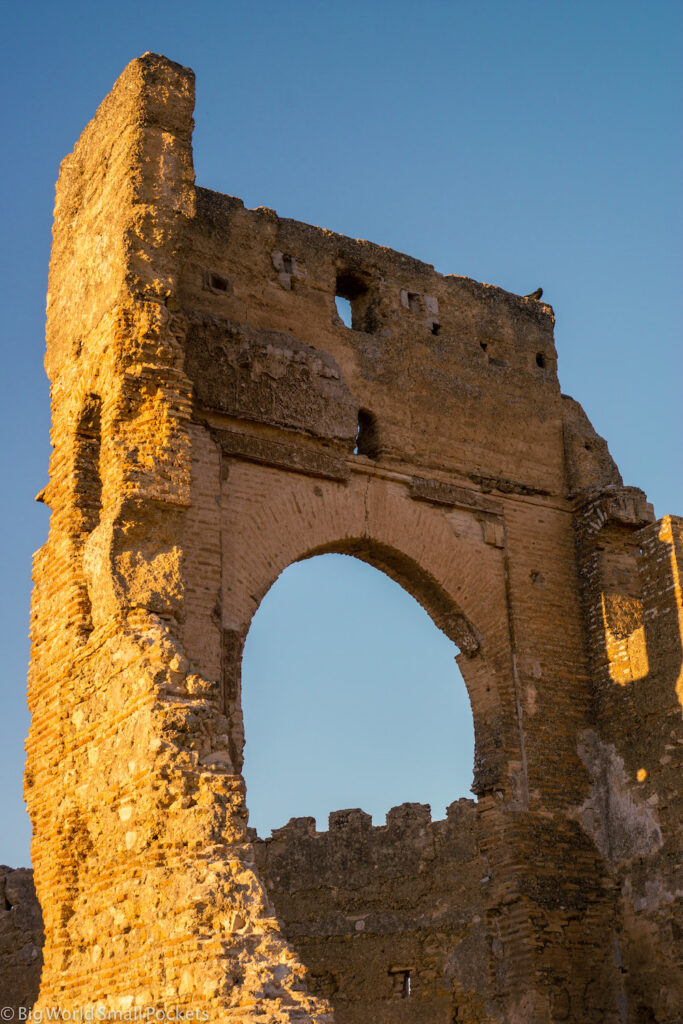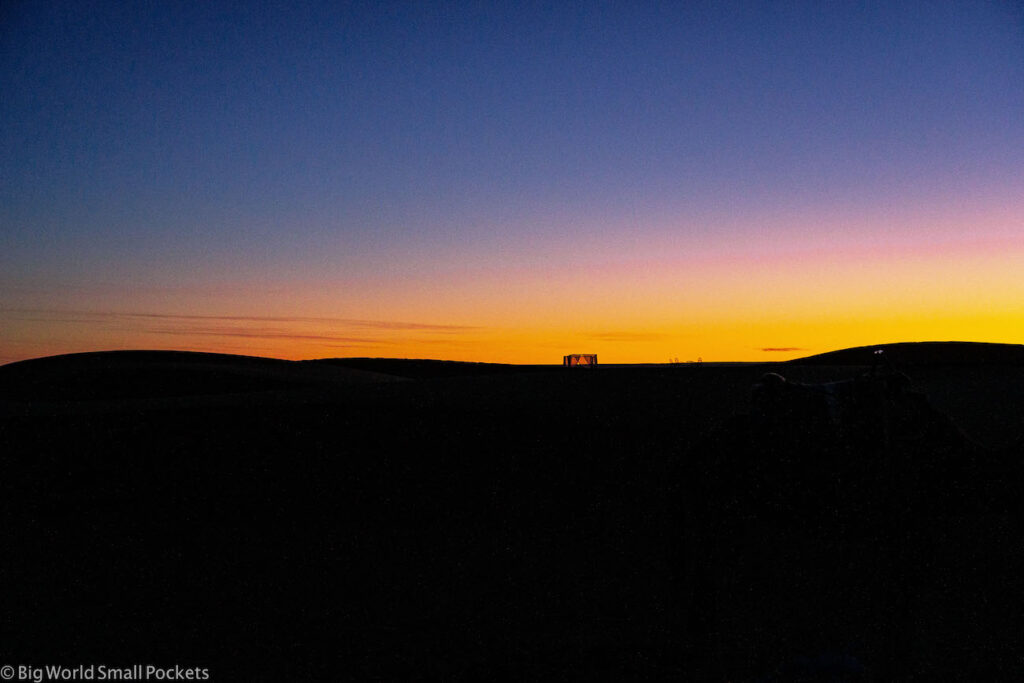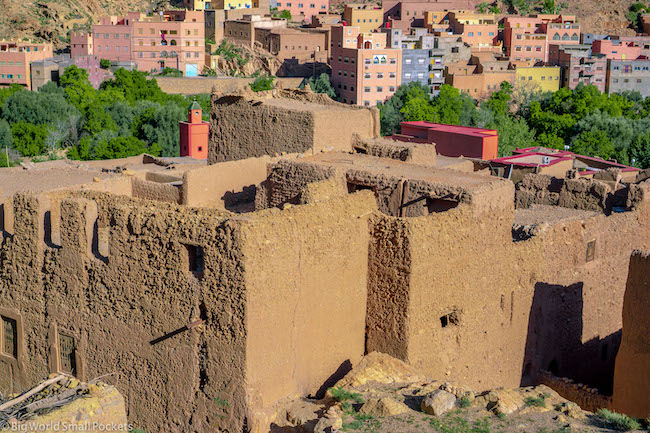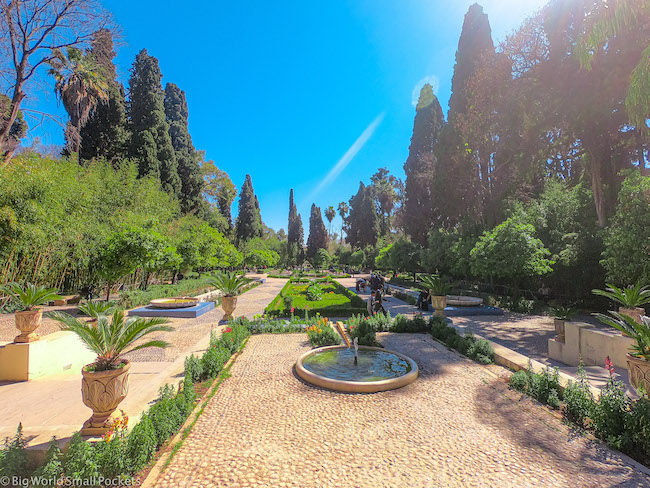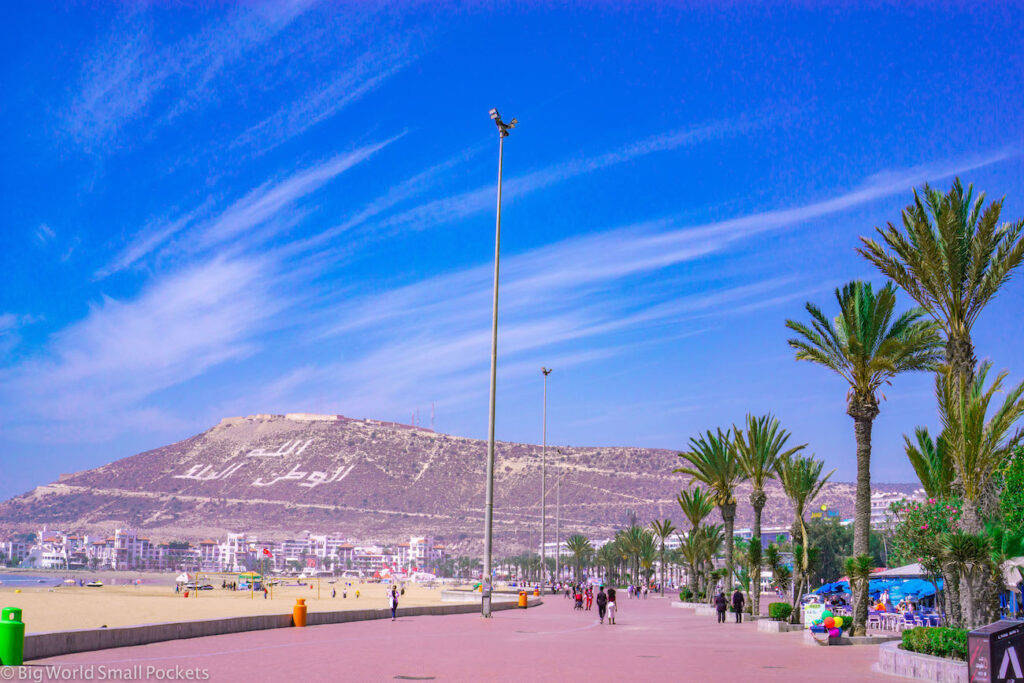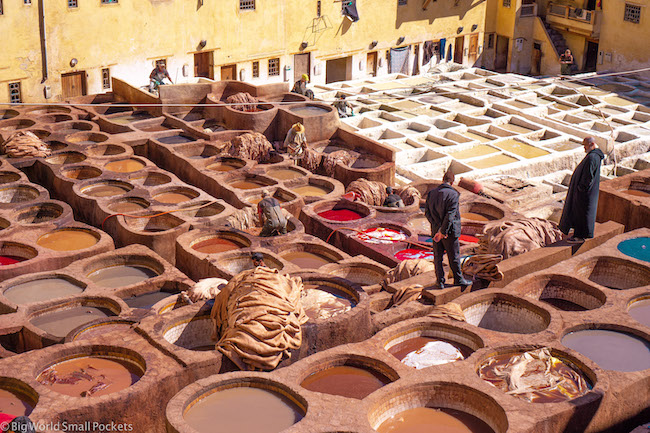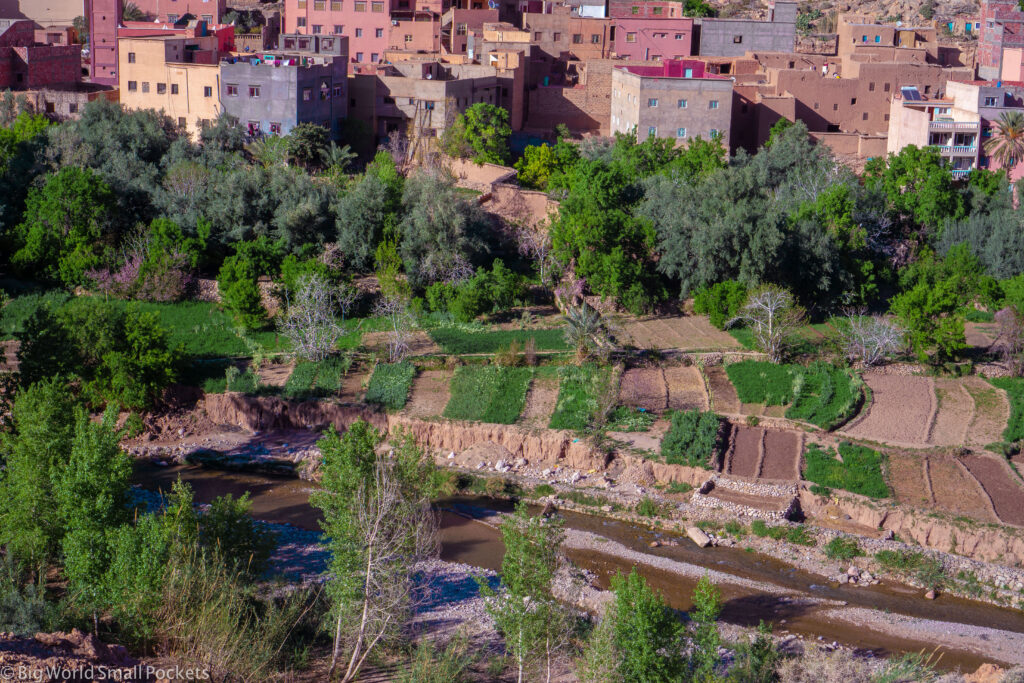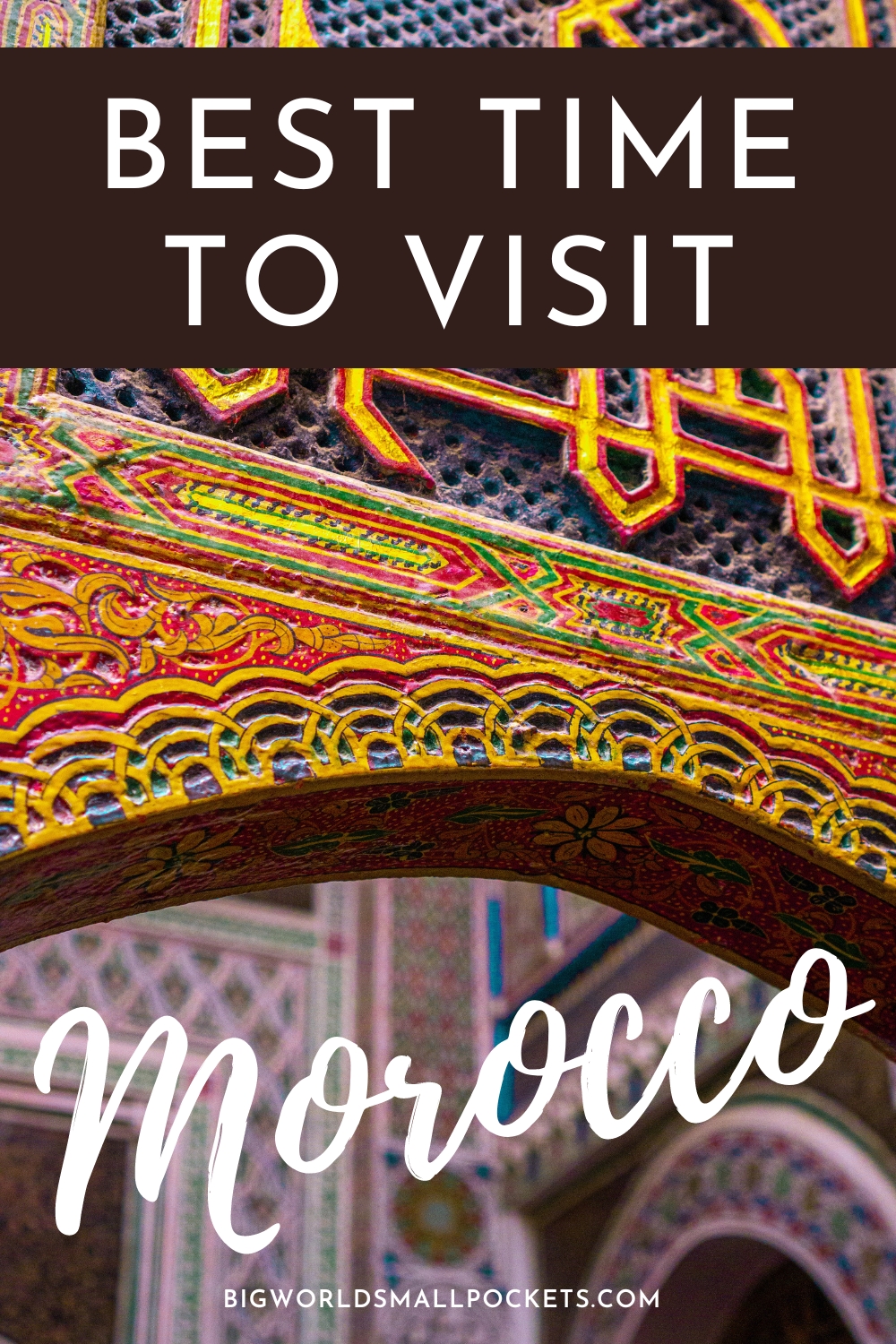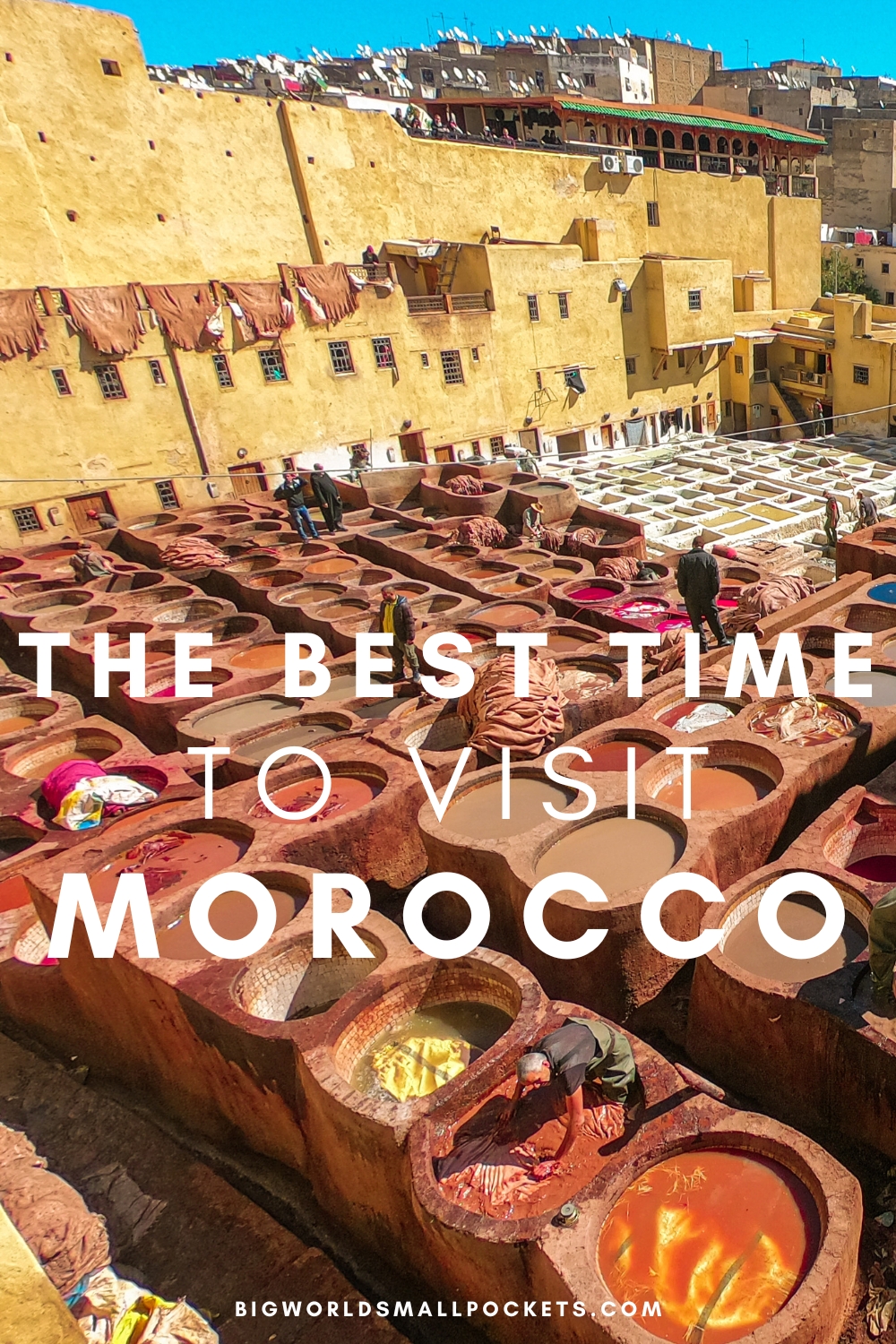It’s quite simple, choosing the best time to visit Morocco is absolutely key in making sure you have a fantastic travel experience there!
Located in north Africa, Morocco is a diverse country, and from the mountains in the north and centre, to the beaches of the west and south, and the deserts of the east, the climate varies wildly across all these varied geographical landscapes, as well as across the 12 months of the year.
So read on to discover when the best time to visit Morocco is depending on exactly what you want to do when you’re there and where you want to go in the amazing country…
Related Posts
- Perfect 2 Week Morocco Itinerary
- Morocco Travel Tips: 21 Things to Know Before you Go
- Top 21 Things to Do in Morocco
This page contains affiliate links meaning Big World Small Pockets may receive a small commission on any purchases at no extra cost to you.
Overall Best Time to Visit Morocco
Overall, the best time to visit Morocco is during the country’s spring or autumn seasons.
This includes the months of April, May and June, plus September and October.
If you plan to visit several different parts of this country – think the Rif or Atlas mountains, the coast for surfing and the beach, or the eastern desert areas including Merzouga – these months provide the best all round balance of blue sky days and good temperatures.
Giving the optimal balance for sightseeing, hiking and sunbathing, visiting during these months will help ensure you aren’t sweltering in some seriously scorching heat and, equally, that your chances of getting a lot of rainy and cloudy days are minimal.
You might be tempted to hit up this country during the hottest, summer months of the year, but be warned, things can get seriously sweaty and uncomfortable at this time of year, especially at the coast as well as in the major cities of Marrakesh, Fez, Tangier, Casablanca and Agadir.
Instead, sticking to the spring and autumn months (especially May, June and September) is definitely the best option for those who want to swim, sightsee, sunbathe and soak in the sights.
Visiting during these months will also mean your trip is unlikely clash with the holy month of Ramadan, which may affect travel plans in this country.
Usually falling in and around the month of April, this key Islamic festival lasts 1 month and dates change each year, so do check when planning your visit regardless.
And if you want to surf when in Morocco, then keep reading to learn more about when best to visit for this activity too…
Morocco’s Climate
At this point, it’s probably worth taking a minute to talk about Morocco’s climate to help you better understand when best to travel here.
Situated in the western corner of north Africa, Morocco lies on the edge of the southern Mediterranean sea, but its territory stretches all the way down to the Sahara Desert.
Tangier, the main Mediterranean city in Morocco, is only about 13km from the closest point in Spain – Tarifa – and therefore, despite being in the African continent, the weather patterns in the north of Morocco most closely resemble those of southern Europe i.e. mild springs and autumns along with hot summers.
In contrast, the south and east of Morocco are covered by large parts of the Sahara.
In this arid environment you can expect minimal rainfall and warm daytime temperatures most of the year.
That said, as is common with desert climates, temperatures can drop drastically during the night.
This is especially true during Morocco’s winter season, which stretches from December to February, when temperatures in the desert regions plummet after dusk.
At the western coast, which is Atlantic Ocean facing, things vary, with temperatures getting warmer the further south you go i.e. towards Agadir.
If you’re coming for surfing, then the best time to visit Morocco is from September through March – essentially winter – when the southeast coastline, most popular with those hitting the waves, is best thanks to consistent swell and mild temperatures (both in and out of the water).
Hottest, Coldest and Wettest Months in Morocco
Across the country, the hottest months of the year in Morocco are July and August, when daytime temperatures regularly exceed 30 degrees celsuis.
In desert regions and inland cities such as Fez, temperatures can reach well into the high thirties during these months, which is why I don’t think they are the best time for visiting Morocco.
Although that said, July and August also boast the lowest rainfall (there’s an average of only 7mm of precipitation across Morocco during these months), which do make them a good time for visiting the north of the country.
Conversely, January is the coldest month of the year in Morocco, when winter descends and temperatures struggle around 13 degrees celsuis in many locations (and even below this in mountain regions like Chefchaouen and The Atlas).
December through March is the wettest time across Morocco – with up to 150mm a month in the northern regions around Tangier and Chefchaouen – so don’t forget to factor this in, particularly if you’re considering a winter break!
If you do want to escape cold Europe for some sun, then I’d certainly head to the south of Morocco instead, where temperatures hang around in the low 20s degress celsius even during winter.
Surfing is also best during these winter months too as I mentioned earlier and, thankfully, most of the key surf spots in the country are located in the south of the country around Taghazout / Agadir.
When to Visit Morocco by Month
January
As discussed, this is one the coldest month across Morocco.
The only regions boasting warm temperatures at this time are the desert and the south, but even here nights can be chilly, so pack accordingly.
Snow can be found in the mountains too.
February
Temperatures warm slightly, but this is still winter in Morocco, so short days, rainfall and cold evenings are to be expected!
That said, if you want to visit when crowds are low and prices are better too, February is a good choice.
March
Spring is arriving, and so are wildflowers, but the north of the country remains chilly!
Days can still be fresh, wet and cloudy across much of the country.
The desert is mild and there’s few tourists around – making it a good time to enjoy those special dunes, like Erg Chebbi, without the crowds!
Just beware of sandstorms during this month.
April
The first month I recommend as the best to visit Morocco, temperatures are now hovering around at least 20 degrees across the country.
Rainfall has reduced and hiking in the Atlas Mountains is optimal, making Morocco a great place to grab some Easter holiday warmth as the days here draw out.
Just remember to check when the holy month of Ramadan (and the celebration that marks its end – Eid al-Fitr) falls.
As a majority Muslim country, many Moroccans observe Ramadan and celebrate Eid, which means opening hours and transport connections can be limited during this time.
May
A great month to visit Morocco, especially as the days are long and light!
May can still bring some cloudy and potentially wet days in the north, but the coast is wonderfully warm and sunny.
Sightseeing is also perfect with comfortable, blue skies days and the desert is still not too hot to be enjoyable.
There’s also many festivals that take place during this month.
June
Another fantastic month for visiting Morocco, especially if you’re seeking some sun, as the mercury climbs higher, but the crowds stay quite low.
Coastal areas also tend to maintain a nice breeze.
The desert is still just about pleasant for visiting still and, in the north, it’s still totally possible to enjoy outdoor active pursuits and sightseeing days in reasonable comfort – pack your sunscreen and a sun hat!
July
One of the hottest months in the country – the desert is unbearably warm at this time and even on the coast it’s really too hot, with temperatures above 35 degrees celsius most days.
Rainfall is low, but walking around ancient towns and ruins may be pretty tough going – drink lots of water if you’re attempting it and stay out of the midday sun.
Hotels also get booked up as this time and prices climb higher thanks to school holidays.
August
Like July, August is super hot and dry everywhere in Morocco.
Steer clear of the south and the desert and avoid mountain trekking.
It’s only really the north coast that is palatable during this month, but if you wouldn’t visit the south of Spain during August, don’t consider Morocco either!
September
Another top month for visiting Morocco; the temperatures are still very good at this time, the days still long and the sea wonderfully warm.
Summer crowds have dissipated at the main holidays spots, meaning you can pick up some great deals at the coast.
Surf season begins and the desert has cooled slightly!
Sightseeing and active adventures are totally possible during this month too.
October
A very popular month to visit Morocco, especially during the half term holiday, temperatures are still warm across most of the country, the sea is still pleasant, the mountains are good for hiking, the desert is bearable and the surf is top notch… what’s not to love?!
It’s also the start of date harvest season and the amazing Festival des Dattes, which makes this month a great time to head to Morocco’s wonderful gorges and palmeraies.
November
Daylight hours are rapidly reducing and rainfall starts to build.
Temperatures also drop, but November can be a good month for desert trips or visiting the Imperial cities of Fez and Meknes.
December
A cool month, with temperatures dropping and rainfall increasing.
Snow can appear in the mountains.
The north can get really cold too and the wind at the coast picks up, making it only popular with surfers!
Best Time to Visit Morocco By Location
Desert
Unbearable in July and August, when you’ll battle scorching temperatures and a plethora of snakes, the desert in Morocco is best visited during April and May or September through November.
At these times temperatures are reasonable – although you’ll still want to pack sensibly with thin light clothing for the day, warm clothes for the night and a head scarf.
Visiting during these months will also help you avoid the sandstorm danger of March and the bitterly cold nights of the winter months.
Atlas Mountains
Snow comes to the Atlas Mountains in winter, and in summer it gets too warm for hiking, which is why March to May and September to October are the best months for enjoying the spectacular scenery here.
This includes the Gorges that are located around the foot of the Atlas, and the palmeraies that can be seen throughout them, where dates are harvested in October and November.
My favourite was Todra Gorge – here’s my travel guide to visiting.
Atlantic Coast
June to October is a great time to hit the Atlantic Coast for those wanting some warm air and sea temperatures.
Things get pretty sticky in July and August and prices soar at these times, so if you’re looking for a quieter, cooler holiday consider either side of these months.
Winter along the western coast of Morocco can be windy and cold, so not great for sunbathing, but ideal for surfers who flock to the southern end of this coastline to get the best from the seasonal swell.
Read my Agadir travel guide here.
Sightseeing Cities
April and May, or September or October, are the best months to visit the historic sightseeing cities of Morocco including Fez, Meknes and Marrakesh.
Fez is my favourite of these cities and you can discover my top things to do in Fez here.
Both day and night time temperatures are pleasant at these times and, outside of school holidays, prices are reasonable.
Just remember to make a note of when Ramadan falls and whether it will correspond with your holiday time – it’s not something to avoid, just to be aware of.
Mediterranean North
The coolest part of the country, I’d avoid the north of Morocco from October to March as things can be wet and grey then and many traditional riads are not set up for the cold.
April brings wildflowers and September is mild and sunny too, so both nice months to visit cities like Tangier and Chefchaouen.
The north of Morocco is the only region I’d consider visiting in the summer months of July and August.
Learn my fav things to do in tourist hotspot Chefchaouen here.
Just enter your email address below and I'll send it to you for FREE!
Information will be sent to the email provided above
Top Travel Tips for Morocco
How to Get There?
Flights to the country’s main international airport, Casablanca, arrive from cities across Europe and beyond.
You can also fly to Tangier, Essaouira and Marrakesh easily.
As always, I use Skyscanner to find the best flight deals.
Alternatively, you can catch the ferry from Spain to Morocco.
How to Get Around?
Trains, domestic flights and buses all allow you to get around Morocco with ease.
Here’s guides I wrote about making some of the most popular tourist journeys…
If you want to visit off the beaten track spots, hiring a car is really the best way to travel the county.
Check out these great Morocco rental car deals.
Top Morocco Tours
Alternatively, if you’d rather not travel Morocco independently, these top tours are another great way to experience the country.
Safety Tips for Your Morocco Itinerary
As a solo female traveller, safety when travelling alone (especially in remote areas) is also big on my radar.
Although I have heard and read reports about female travellers being harassed in Morocco, I haven’t experienced any of that myself and can only say that I felt incredibly safe here the whole time.
That said, there’s a lot of common sense involved in safety too.
My advice is to stick with other travellers, don’t wander out alone at night and always be clear about your boundaries in all situations.
You’ll also want to ensure you drink enough water in Morocco’s hot and dry climate as dehydration is probably one of the biggest dangers here too.
Travelling with a LifeStraw Go Water Bottle, which you can use to purify water from any fresh water source is a top option to help you do this.
I bought one for my trip to Morocco – as it then allowed me to drink the tap water safely – and now wouldn’t be anywhere without it!
Sun protection is another thing to factor in for this country and packing clothes (like a cap or hat) and lotion that will protect you from the strong UV rays is definitely recommended.
Travel Insurance for Morocco
World Nomads offers simple and flexible travel insurance. Buy at home or while travelling and claim online from anywhere in the world.
Alternatively, if you’re a long-term traveller, digital nomad or frequent remote worker seeking travel health cover, check out Safetywing’s Nomad Insurance policies.
Travel Money for Morocco
When it comes to paying for things in Morocco, you want to ensure you’re not being charged overseas transaction fees or getting poor exchange rates when using your card abroad, which is why I always take my Wise card away with me wherever I travel.
The easy way to spend abroad with real exchange rates, no markups and no sneaky transaction fees, you can use your Wise card just like a debit card here… and it links easily with Google and Apple pay – sold! Grab yours here.
Top 7 Things To Pack for Morocco
Here’s my top 7 recommended packing items for Morocco or take a look at this full Morocco packing list I wrote.
- Warm, Travel Coat
- Travel Towel
- Birkenstocks or Sandals
- Good Day Pack
- Sony A6000 mirrorless camera
- Life Straw Go Water Filter Bottle
- Moroccan Arabic Phrasebook
PIN IT TO PINTEREST!
And there you have it, my guide to the best time to visit Morocco.
Have anymore questions about when, where and how to travel this country?
Don’t hesitate to get in touch using the comments box below…

